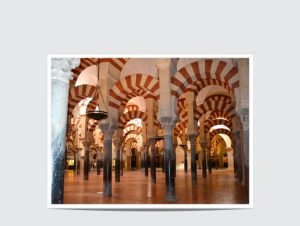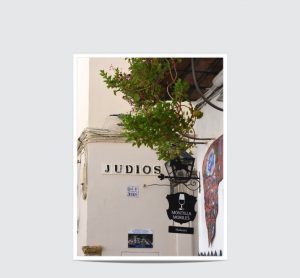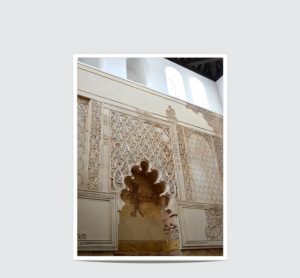It was only 9 a.m. and the wall of 110-degree heat that engulfed me as we stepped out of the air-conditioned rented car made me question whether this day trip to Cordoba was worth it. We were staying 90 kilometers away in Seville, but were eager to see the Great Mosque and visit one of the few intact synagogues that remain in Spain. Parking was easier than we thought, with options on Paseo de la Ribera, or at a nearby garage designated for Mosque parking. The real challenge, as with most European car parks, was the size of the spots. Suddenly our free upgrade to a large luxury four-door sedan was looking more like a curse than a freebie.

Anxious to avoid the lines, we headed towards the Mezquita-Catedral de Cordoba. Construction began around 784 and lasted for two centuries. In 1236, King Ferdinand III of Castille conquered the city, and the mosque was converted to a Catholic church. Chapels and adornments galore were added, and the minaret was turned into a bell tower. The massive structure is breathtaking, with its opulent mix of Moorish, Gothic, Baroque and Renaissance influences. According to Brendan Sainsbury in Lonely Planet, the Cathedral was built as a democratically horizontal and simple space, where the spirit can roam free. Wandering through this magical maze, I could almost feel the spirit when I noticed an elderly Muslim woman struggling to slide against one of the columns to rest on the floor. Just as she made it to the ground, a guard tapped her on the shoulder motioning for her to stand up, as apparently loitering is not permitted. I understand that the Cathedral is also a museum and has rules, but I desperately wanted to remind him that she had some claim to that ancient stone floor.
To best see the Jewish Quarter, we followed an itinerary prepared for us by our guide in Seville, Jorge Gershon, whose knowledge, expertise and passion for Jewish life are contagious. We trekked from the bottom of the ancient city near the Mosque towards the top to Murralas y Puertas de Almodovar, or the gate to the Old Jewish Quarter. (The sun was scorching as midday approached, but it was worth every ounce of sweat.) We turned right on Calle Judios, Street of the Jews, where my imagination had to work overtime to conjure images of a bygone, vibrant Jewish community. Other than a few markers here and there, and businesses using words such as “Juderia” or “Mazal” to remind us of this city’s rich past, the Quarter is indistinguishable from the rest of the city.

A short way down Calle Judios is Casa de Sefarad, a museum and former home now housing a collection of artifacts, musical instruments, books, costumes, Judaica and important writings. Ancient, enlightened Cordoba is the birthplace of Maimonides, and his life and works are incorporated into the exhibits. I was surprised to learn that a non-Jewish benefactor with a passion for preserving this integral part of Spain’s history financially supports this museum.
Just across the narrow street is one of Spain’s three significant synagogues, which was built in 1315. The whitewashed building is small and devoid of Sifrei Torah or artifacts. It is unimpressive as compared with the magnificently ornate churches of Spain but is beautiful in its simplicity and clarity of purpose as a house of worship. Twelve of the fifteen windows along the top of the building remain open to symbolize the tribes of Israel.
 Continuing down Calle Judios, we reached Plaza Maimonides, and the statue erected in honor of this famous Cordovan philosopher, theologian, and doctor. His famous quote, “Teach thy tongue to say ‘I do not know,’ and thou shalt progress,” still resonates today, and perhaps even more loudly. We ended our tour at Plaza Judah Levi, named after the Spanish Jewish poet, philosopher and doctor born in 1075.
Continuing down Calle Judios, we reached Plaza Maimonides, and the statue erected in honor of this famous Cordovan philosopher, theologian, and doctor. His famous quote, “Teach thy tongue to say ‘I do not know,’ and thou shalt progress,” still resonates today, and perhaps even more loudly. We ended our tour at Plaza Judah Levi, named after the Spanish Jewish poet, philosopher and doctor born in 1075.
Walking away from El Barrio de la Juderia, and making our way towards the river, we arrived at the Alcazar of Cordoba, which was built by Alfonso XI of Castile in 1328. The Castle eventually served as one of the Inquisition’s headquarters. It is hard to ignore the contrast between this grand architectural masterpiece, which housed torture and interrogation chambers, and the few and modest reminders of Cordoba’s rich Jewish past.
 Maimonides said, “I will destroy my enemies by converting them to friends.” I wonder what Cordoba’s Jewish community would look like today had Ferdinand and Isabella embraced this line of thinking?
Maimonides said, “I will destroy my enemies by converting them to friends.” I wonder what Cordoba’s Jewish community would look like today had Ferdinand and Isabella embraced this line of thinking?

This article brought me back to my own visit to Cordoba, many years ago. (It was also very hot that day). Thanks for sharing Erris!
Your writing invoked such beautiful scenes, that I thought I was walking beside you. Your writing reflects your intellectual and spiritual experiences in Portugal and Spain.